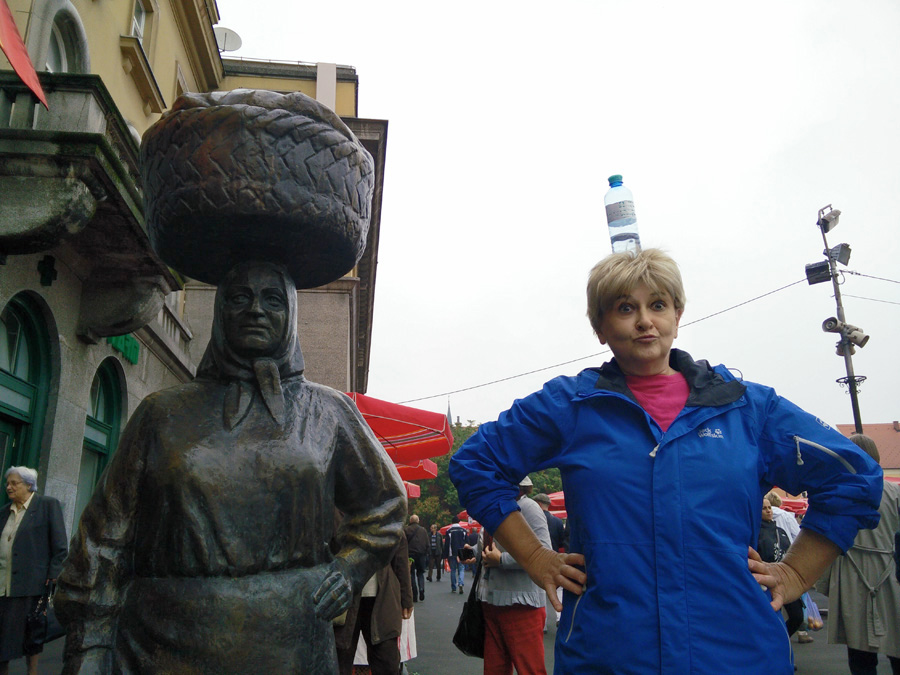Kumica - Superhero from Dolac
You'll find that Zagreb is filled with monuments and statues dedicated to great historic persons or religious figures. Among them all, though, one statue stands apart. It's located at Dolac, Zagreb's central and most frequented farmer's market, and it's quite humble. The person depicted has no name and can't be found on Wikipedia, but the history of Zagreb wouldn't be the same without her. Made by sculptor Stjepan Gračan and erected in 2006, this statue is called kumica and it pays well-deserved respect to all these hard-working women that have been feed the citizens of Zagreb for hundreds of years.

“Kumica loves to pose with tourists”. Image credit: Taste of Croatia
You simply cannot translate the word kumica, being so local and specific, you need to describe it. Let's say it's a generic term for a peasant woman, usually older, from the rural surroundings of Zagreb (Turopolje, Prigorje, Zagorje and so on), who worked as farmers and market vendors, selling their own home-grown seasonal produce. They were no big-scale farmers, just regular people from the countryside living off the land, owning a garden, some cattle, chicken, nothing special. Early in the morning they would put the fresh produce in a big woven basket they carried on their heads and take the first morning train to Zagreb, sell their goodies to city folks and get back home to produce some more. Mostly we’re talking about dairy, especially Zagreb’s beloved fresh cream and cottage cheese, eggs, soup greens (grincajg, as we say), walnuts, corn bread, small fruits and veggies. Not an easy living, definitely. But nowadays our idea of kumicas from the past has a romantic aura and folklore feel to it.

“Kumica in her natural habitat”. Image credit: ZTB, author Marko Vrdoljak
What about today? Are there any authentic kumicas left out there, what’s their role in the modern times? Luckily, the legendary kumica is not yet entirely extinct, she lives on, although some things have changed a bit. Many small farmers from the surrounding villages have their regular stands at Dolac and other markets in Zagreb, but you won’t really see them wearing baskets on their heads or catching trains at dawn. They compete with farmers from all parts of Croatia, big-scale producers, food importers and middlemen for their share on the market. Working hands, big smile, Kajkavian dialect, excellent multitasking skills, long skirt, apron and a headscarf are telltale signs that you’re dealing with a kumica, but there could be exceptions, of course. At Dolac they have several “turfs”, depending whether they specialize in dairy or fruits and veggies - you can find them clustered in the dairy department of both the outdoor and the indoor section, with some more scattered among the outdoor fruit and vegetable stands. In the main indoor section, there are two rows of stands operated by modern kumicas just below the flight of stairs. Frequent visitors of Dolac usually have their own kumica with whom they develop a special long-term relationship, benefiting both sides.

“Dairy kumica selling homemade cream and cheese”. Image credit: Taste of Croatia
It’s true, today we have plenty more options when buying groceries and the golden days of kumicas are gone, but Zagrebians will always love them and cherish them. Call us naive and sentimental, but in our minds kumica is something like a superhero safeguarding all things local, traditional and green. Even Margaret Thatcher couldn’t resist kumica’s call when she visited Dolac Market in 1998! As part of Zagreb Time Machine programme, on Fridays and Saturdays from April to October, women dressed in Prigorje folk costume will try to revive the memory of old-school kumicas and days long gone.

“Local folklore clubs reviving the golden age of kumica”. Image credit: ZTB, author Marko Vrdoljak
Header image credit: ZTB, author Marko Vrdoljak
Author: Taste of Croatia
